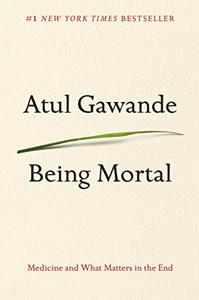
Want to learn the ideas in Being Mortal better than ever? Read the world’s #1 book summary of Being Mortal by Atul Gawande here.
Read a brief 1-Page Summary or watch video summaries curated by our expert team. Note: this book guide is not affiliated with or endorsed by the publisher or author, and we always encourage you to purchase and read the full book.
Video Summaries of Being Mortal
We’ve scoured the Internet for the very best videos on Being Mortal, from high-quality videos summaries to interviews or commentary by Atul Gawande.
1-Page Summary of Being Mortal
Overview
Atul Gawande’s book, Being Mortal, is about death. It brings up many concepts like mortality and terminal illness. He includes research and tells the stories of his patients, other doctors’ patients, and his family members. The results are a guide to help people make decisions in their final days or years—especially for those who are ill or dying.
Gawande explores different ways to deal with sickness and aging. He discusses the positives and negatives of each option, such as hospitals, nursing homes, assisted living, and hospice care. Autonomy is important in these situations because it’s what people want when they’re dying or sick. Gawande also talks about other concepts related to death that are important for anyone dealing with this situation: whether you should pursue treatment even if it might not be successful or could diminish your quality of life.
Throughout the book, Gawande shares personal stories to illustrate his points. One such story is about his father and how he was able to live a good life despite being paralyzed by a tumor. He also calls for doctors to examine their practices with patients who face imminent death and stresses the importance of palliative care in medicine.
Key Point 1: Nursing homes were not created to assist the elderly with their dependency on others or provide a better option than poorhouses. They were created to clear out hospital beds.
After the industrial revolution, hospitals became a place for people to go when they were sick. They also took care of old people who needed help with their health problems. Soon, there weren’t enough beds in hospitals for all the sick and elderly people. So, government officials decided that older patients should be moved into separate units called nursing homes so that hospital beds could be freed up for other patients.
Nursing homes were originally created to help the sick and elderly, but they have evolved into something different. They are now places where patients go to live out their last days in comfort. However, some nursing homes do not meet the expectations of their residents or their families because they don’t focus on improving the quality of life for the terminally ill and elderly.
When caring for a number of ill and dependent people, caregivers fall back on rigid schedules. This eliminates the feeling that they can do what they want when they want to. They have no flexibility in their schedule because it is so strict.
While nursing homes are not necessarily the problem, they do tend to be a major source of issues. One sociologist compared them to prisons, military camps, orphanages and mental hospitals. These institutions all have one thing in common: They’re total institutions that take away a person’s freedom by doing away with their private life. This is why nursing homes don’t provide good care for dying patients.
Key Point 2: Assisted living arose from the need for an alternative to nursing homes that could give patients more independence and control over their lives.
Assisted living offers patients more autonomy than nursing homes do. Nursing homes often control patients’ lives by restricting their freedom, but assisted living facilities offer them the ability to make decisions and have a say in what happens to them on a daily basis.
Even if nursing home residents are physically limited, they still want some sense of independence and control. Assisted living facilities provide that more than nursing homes do. Nursing homes don’t feel like actual homes to the people who live there, but assisted living facilities do.






